|
FAQs on Anemone Identification
28
Related Articles: Anemones,
Bubble
Tip Anemones, LTAs, Cnidarians, Coldwater Anemones, Colored/Dyed Anemones,
Related FAQs: Anemone ID 1, Anemone ID 2, Anemone ID 3, Anemone ID 4, Anemone ID 5, Anemone ID 6, Anemone ID 7,
Anemone ID 8,
Anemone ID 9, Anemone ID 10, Anemone ID 11,
Anemone ID 12,
Anemone ID 13, Anemone ID 14, Anemone ID 15, Anemone ID 16, Anemone ID 17, Anemone ID 18, Anemone ID 19, Anemone ID 20, Anemone ID 21, Anemone ID 22, Anemone ID 23, Anemone ID 24, Anemone ID 25, Anemone ID 26, Anemone ID 27, Anemone ID 29, Anemone
ID 30, Anemone ID 31, Anemone ID 32, Anemone ID 33, Anemone ID 34, Anemone ID 35, Anemone ID 36, Anemone ID 37, Anemone ID 38, Anemone ID 39, Anemone ID 40, Anemone ID 41,
Anemone ID 42,
Anemone ID 43,
Anemone ID 44, Anemone ID 45,
& Cnidarian Identification, Anemones 1,
Anemones 2, Anemones 3, Anemones
4, Anemones 5, Invertebrate Identification, Aiptasia
Identification, Aiptasia ID
2, LTA
Identification, Bubble Tip
Anemones, Caribbean
Anemones, Condylactis, Aiptasia
Anemones, Other Pest
Anemones, Anemones and
Clownfishes, Anemone
Reproduction, Anemone
Lighting, Anemone Feeding,
Anemone Systems,
Anemone
Compatibility, Anemone
Selection, Anemone
Health, Anemone Behavior,
Anemone
Placement,
|
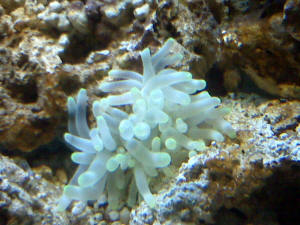
|
 |
New Print and
eBook on Amazon:
Anemone Success
Doing what it takes to keep Anemones healthy long-term
by Robert (Bob) Fenner
|
|
Please ID This Anemone: Corallimorph - Likely
Pseudocorynactis sp. -- 10/8/09
Hi,
<Hi Jan, Lynn here today.>
First let me say that your site is my marine bible.
<Thanks! Bob has indeed put together quite a wealth of
knowledge!>
I browse here before anywhere else. Thank you for being here.
<It's our pleasure.>
Someone in my reef club put this gorgeous anemone up for trade
[IMG]http://i210.photobucket.com/albums/bb66/janvl07/unkownanemone.jpg[/IMG]
I think it's a cold water anemone, but my knowledge is
limited.
<Hopefully, it's not a cold water species in a reef tank!
It looks like what's commonly called an orange ball anemone,
although these are actually Corallimorphs (like mushrooms --
Rhodactis, Ricordea, etc.) instead of anemones. The individual
photographed is either a species in the genus Corynactis (usually
small, tends to live in cold/cooler waters), or Pseudocorynactis
(a more tropical variety, can get fairly large). This individual
is more likely of the latter genus. For more information, please
see the following link:
http://www.advancedaquarist.com/issues/oct2002/invert.htm
>
No one knows where it's from and what it is.
<Hopefully, this information will help. By the way, it's
been noted that the larger Pseudocorynactis spp. individuals can
pose a threat to fish, so beware. I don't know the size of
the one photographed, but it looks fairly large. The hitchhiking
individuals we most commonly see are the species Pseudocorynactis
caribbaeorum. They're usually very small and fairly
innocuous. They also tend to open mostly at night although over
time, some will adapt and remain open during the day. You can
find more information within WWM's FAQs regarding these
beautiful little Corallimorphs.>
The person that had it up for trade won't tell anyone where
it's from.
<He/she might not know.>
Thank you.
<You're very welcome!>
Best regards,
Jan
<Take care, LynnZ>
|
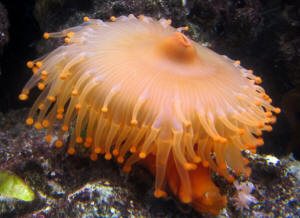 |
|
Anemone ID, and a note re the death
biz 4/11/09
Hello,
<Howsit?>
Just a quick question. I recently got stationed at Vandenberg AFB
on the central coast of California. There are a few beaches that
are actually on the base and while exploring one of them at low
tide i happened to stumble upon about a thousand or more of these
anemones. Sorry about the quality of the pic it was taken with my
blackberry. I never thought that such cold water would hold such
a variety of different colored anemones. There were green,
orange, blue, purple, red, and others that i cant remember right
now. Anyway to the question what type of anemone are these and
would it be possible to keep them in a central California coast
themed tank?
<Is... and are Anthopleura xanthogrammica... The
"giant" (larger with ecoclinal variation toward the
north) "California" (except when elsewhere) Green Sea
Anemone>
Not that I'm actually thinking of removing them straight from
the ocean just curious.
Thanks,
Kris
<Watch that curiosity... Bureaucracies like the military
destroy such that leads to innovation... makes the folks at the
top look inept (they are), and who wants to appear inept. Cheers,
Bob Fenner>
|
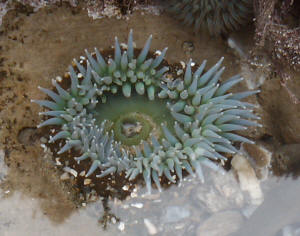 |
|
Anemone ID 3/24/09
Hello, hope all is well!
<Is good, still above ground.>
I need some help ID'ing a hitch hiking anemone I recently
discovered. When it first showed up in my tank about 2 months ago
it was about the size of a penny and had bulb like tips which led
to believe it was a baby bulb anemone of some type. After feeding
and caring for it grew to about an inch in diameter and has now
split into four separate animals all bigger
than the original. Am I right in thinking it's some
form of Majano? I know they are know for
multiplying like crazy.
<Yes, appears to be a majano/tulip anemone, Bob may input here
if not. Bubble Tip Anemones would not multiply/split
that fast and at that size.>
Any insight into this mystery Anemone would be more than
appreciated.
Thank you.
<You're welcome. James (Salty Dog)>
Michael
|
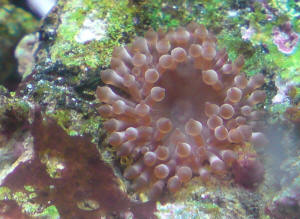 |
|
Anemone ID 3/23//09
Hello Bob,
Wondering if you could peek at the anemone ID query in my inbox.
Photo appears to be a
Heteractis, likely a crispa. Your educated ID?
I'd ask for another photo or two. B>
By the way, Mich sent me a few photos of the Michigan trip. Geez,
I see you were in a belly photo contest with another gent. Thank
God you were not drinking yet, no telling how far that would have
went:).
Cheers,
Jim
<Was already drinking... B>
Anemone ID 3/23/09
Hello,
<Hi>
I am having trouble getting an Id on this guy.
The person who originally bought this guy said he was yellowish
w/ pinkish/purple tips, now I am sure he was dyed as you can see
he has reverted back to his natural colors ( or at least on his
way ).
His tentacles have a " ribbed" look to them ( about 2
or 3 ribs per tentacle).
The way he is sitting its hard to see his mouth but it has a
whitish ring around it.
My Allard's love him.
great site, its good to have a resource like this, but you
probably already know that already.
<Appears to be a Heteractis, likely a crispa. A couple
additional photos, preferably taken at a higher angle would help
lead to a more accurate ID.>
Cheers!
<Ditto my friend. James (Salty Dog)>
|
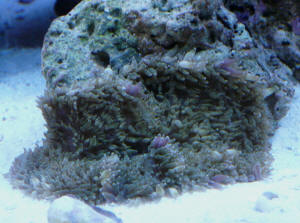
|
Re: Anemone ID
3/26/09
Is this a little better angle?
<Yes, and after looking at numerous anemone scans,
including Mr. Fenner's, I do not believe it is a
crispa, likely either an aurora or malu with more emphasis
on the later. This anemone does not appear to be in the
best of health which makes it a little more difficult to
ID. Bob, any input from the shores of Cozumel?>
Thanks again.
<You're welcome. James (Salty Dog)>
Re: Anemone ID
3/26/09
Thank you for the speedy responses,
<You're welcome.>
I have only had this anemone for about a week now, the
person I purchased this from was under the impression it
might be a carnation anemone? I can find very little info
about Carnation anemones so that's why I contacted the
people in the know.
<Mmm, Carnation Anemones are generally a light to deep
yellow in color.>
I think it was under 4-39w t5's maby <maybe>
more, I have it in a 110gal, 2x400w MH lit tank and have
started to notice towards the end of my MH light cycle the
some tenticles <tentacles> are turning a nice "
Healthy bubble tip green" color. If you know what I
mean.
<Yes, the intense lighting will help.>
There might be hope.... I hope.
<I'm keeping my fingers crossed for you. James
(Salty Dog)>
|
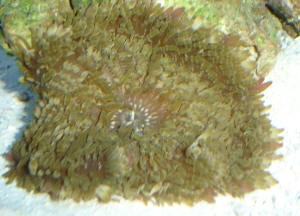 |
|
|
Anemone ID 3/23/09
Can you identify this anemone?
<Is a Condylactis or Haitian Anemone.>
The pet store told me it was a Haitian. But I can't find any
on the web that have green tips on ends of tentacles. Foot is red
and it seems to want to get as deep into the cracks in the rock
as possible. Have only had it for a few days and just want to
identify it before I try to feed it. Also need to know light
requirements.
<Now you are asking about light requirements. They do require
intense lighting and this anemone is bleaching badly from lack
of.>
Any help would be appreciated. I usually don't buy before I
know all about the species I am buying but my wife loved it and
the store owner swore to her that it would be a host to our
clown. By the way the clown has shown zero interest.
<Not surprising, the Condylactis are not hosting anemones and
are found in western tropical
Atlantic waters where no clownfish exist. James (Salty
Dog)>
|
 |
|
Critter ID? Operculums and Possible Sand Anemone -
3/19/09
<Hello Christopher, Lynn here this morning.>
A shell of a what?
<More like what's in the shell!>
One might think that after 40+ years of fishkeeping, 8 years of
outright reef obsession, and being supported by the bountiful
resources of WW, I could tell, or at least easily discover, if
something is a mollusk or a worm, or neither.
<Heheee! I've been in the hobby since the early 70's
and believe me, it happens.>
I recently had the opportunity to go bigger (50g to 125g).
<Nice>
After the 6 months of preparation, moving, acclimation,
quarantine, and additions to the new system, I finally have my
dream tank, short of glass walls everywhere. Thanks to advice
found on your site, I have had great success, the move went
swimmingly and the only surprises have been how much both my reef
inhabitants and I enjoy the larger space and there are these
shells. I have identified dozens of the hundreds of
'hitch-hiking' organisms that have populated my system
over the years and continue to pop up. While moving the old sand
bed as a 'start' for the new larger one I decided to sift
out some of the rubble that had accumulated from generations of
free limpets, tubeworms, Chitons, Nerites, Vermetid snails and
from the not-so-free snails, hermit crabs, coral base rocks and
the like. (A pair of maroon clowns can tend to break a lot of
things around their house over the years) Among the remains, I
discovered those of an animal that I had never seen before but it
had obviously thrived and multiplied for some time. They appear
to live or have lived on the glass bottom under the sand. What is
left are disk-shaped hard shells with a completely flat, almost
polished bottom and an intricate spiral growth pattern on the
top. I have attached a photo of the 'shell remains' that
I found in great numbers (dozens, perhaps hundreds) in the sand.
The three at the top are turned upside down to show the bottom
surface.
<They're snail operculums/opercula - the trap door at the
opening of a snail that protects the soft animal inside from
predation, desiccation, etc. Some are thin, and flexible, while
others are thick and calcareous. Yours are obviously of the
latter variety and most appear to be from bygone Turbo snails.
See these links for more information/comparison:
http://aphriza.wordpress.com/2006/12/21/trapdoor-on-the-seafloor/
http://seashellplace.com/catalog/images/others_eye_green.jpg
http://farm4.static.flickr.com/3261/2319171639_4443687a10.jpg
http://en.wikipedia.org/wiki/Operculum_(gastropod) >
I later remembered a photo I took a few years ago of some other
unidentified animals that I occasionally saw poking out from the
sand. After scouring your site at the time I assumed them to be
some sort of small anemone. I never could get a real up-close
observation of it and the only photo I got was this poor one
taken before I read all of your cautions about using a zoom lens
to take a close up in my aquarium. Perhaps it will be clear
enough for you to tell what kind of creature it is and whether it
is perhaps the maker of the shells?
<I sure wish I could help with this one, but I can't see
it well enough to be able to determine what it is. If I had to
guess, I'd say that it might be some kind of anemone,
possibly a sand anemone (Phyllactis spp). Please see the photo at
the following link for comparison:
http://www.flickr.com/photos/lemurdillo/3044460357/in/set-72157605663802360/
>
As you can tell it is about twice the size of a typical xenia
polyp. It had what appeared to be a plume of translucent fleshy
brownish speckled tentacles protruding from the 4-5' sand bed
next to the base rock. I am stumped by these guys and can't
seem to find images or descriptions of similar organisms.
FYI: 125 Gallon, 20 gal sump/refugium, deep sandbed, all
parameters are good.
Lots of healthy live rock with colorful algae, sponges,
tunicates, worms, tiny seastars, pods, macro algae, etc, etc. and
mature colonies of soft corals introduced years ago and
re-established over the rockwork.
Corals: Mushrooms, leathers, xenia and Zoanthids
A theme of relationships:
2 -- Maroon Clownfish (Premnas biaculeatus) mated pair (7 yr)
1 -- BTA (Entacmaea quadricolor) hosts above in separate
'bommie' (6 mo)
1 -- Pink Spotted Watchman Goby (Cryptocentrus leptocephalus) (4
yr)
1 -- Tiger Pistol Shrimp (Alpheus bellulus) (3 yrs)
5 -- Lyretail Anthias (Pseudanthias squamipinnis) (5 mo)
1 -- Blue Devil Damsel (Chrysiptera cyanea)
1 -- Midas Blenny (Ecsenius midas) (1 yr)
4 -- Canary Wrasse (Halichoeres chrysus) (1-5 yr, 3-4 mo)
2 -- Cleaner Shrimp (Lysmata amboinensis) (4 yr)
Grateful to have and to share it all. Any comments are
welcome.
Christopher Williams
Santa Barbara, CA
<Hope that helps! Take care, Lynn Zurik -- Everett, Wa>
|
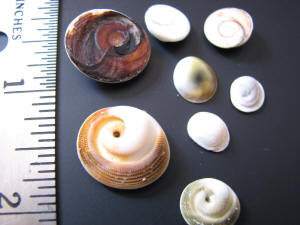 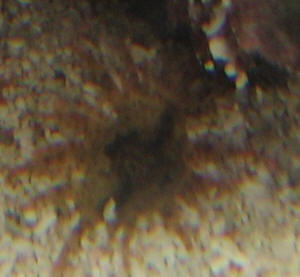 |
|
|

